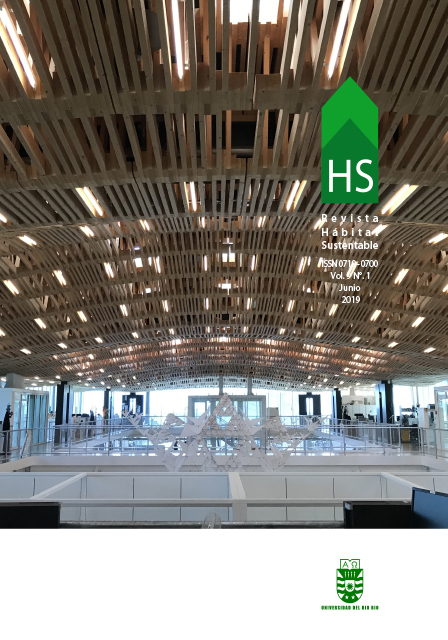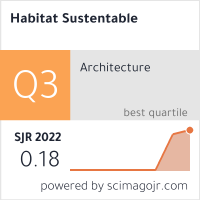Propiedades energéticas de tecnologías de ventanas en Argentina
DOI:
https://doi.org/10.22320/07190700.2019.09.01.04Palabras clave:
ventanas, índices, energía, desempeño, simulaciónResumen
Las ventanas influyen de manera significativa en las demandas energéticas para calefacción, refrigeración e iluminación de los edificios. En este trabajo, se caracterizan las propiedades energéticas de las tecnologías de ventanas disponibles en Argentina, mediante el cálculo de sus índices K, FS y TV (transmitancia térmica, factor solar y transmitancia visible). Se analiza, además, el impacto que tienen diversos parámetros, como las dimensiones de la abertura, la tipología, el material y la absortancia solar del marco, sobre los índices mencionados. Los casos de estudio se seleccionaron cuidadosamente para asegurar una buena representatividad de la muestra analizada, utilizando, en particular, el método de análisis de conglomerados. El cálculo de los índices se realizó con el apoyo de los programas WINDOW 6.3 y THERM 6.3. Los resultados indican que los valores de K están comprendidos entre 1.88 y 6.00 W/m2K, mientras que los valores de FS varían entre 0.08 y 0.80, y los de TV entre 0.03 y 0.80, según el material del marco, la tipología y el tipo de vidriado.
Descargas
Citas
ALWETAISHI, Mamdooh. Impact of glazing to wall ratio in various climatic regions: A case study. Journal of King Saud University-Engineering Sciences, 2017, vol. 31, n° 1, pp. 6-18.
APPELFELD, David; HANSEN, Christian S. y SVENDSEN, Svend. Development of a slim window frame made of glass fibre reinforced polyester. Energy and Buildings, 2010, vol. 42, n° 10, pp. 1918-1925.
BURATTI, Cinzia; MORETTI, Elisa y ZINZI, Michele. High energy-efficient windows with silica aerogel for building refurbishment: experimental characterization and preliminary simulations in different climate conditions. Buildings, 2017, vol. 7, n° 1, p.8.
CARDINALE, Nicola; ROSPI, Gianluca y CARDINALE, Tiziana. Numerical and experimental thermal analysis for the improvement of various types of windows frames and rolling-shutter boxes. International Journal of Energy and Environmental Engineering, 2015, vol. 6, n° 2, pp. 101-110.
DE GASTINES, Maureen; CORREA, Érica y PATTINI, Andrea. Window frame thermal performance simulation. Suitable methods according to climate and technology. Journal of Construction, 2018, vol. 17, n° 1, pp. 112-122.
DE GASTINES, Maureen y PATTINI, Andrea. Cálculo de precisión del factor solar de ventanas. En: XL Reunión de Trabajo de la Asociación Argentina de Energías Renovables y Medio Ambiente, 2017, vol. 5, pp. 08.167-08.175.
DE GASTINES, Maureen; VILLALBA, Ayelén y PATTINI, Andrea. Improved model for the thermal performance calculation of non-planar window frames for building simulation programs. Journal of Building Performance Simulation, 2016, vol. 9, n° 6, pp. 633-647.
GRANZOTTO, Nicola; BETTARELLO, Federica; FERLUGA, Alessio; MARSICH, Lucia; SCHMID, Chiara; FAUSTI, Patrizio y CANIATO, Marco. Energy and acoustic performances of windows and their correlation. Energy and Buildings, 2017, vol. 136, pp. 189-198.
INSTITUTO ARGENTINO DE NORMALIZACIÓN Y CERTIFICACIÓN. IRAM 11603: Acondicionamiento térmico de edificios. 2012.
INTERNATIONAL ENERGY AGENCY. Technology Roadmap - Energy efficient building envelopes. International Energy Agency, 2013.
JELLE, Bjørn Petter; HYND, Andrew; GUSTAVSEN, Arild; ARASTEH, Dariush; GOUDEY, Howdy y HART, Robert. Fenestration of today and tomorrow: A state-of-the-art review and future research opportunities. Solar Energy Materials and Solar Cells, vol. 96, pp. 1-28, 2012.
LECHOWSKA, Agnieszka A.; SCHNOTALE, Jacek A. y BALDINELLI, Giorgio. Window frame thermal transmittance improvements without frame geometry variations: an experimentally validated cfd analysis. Energy and Buildings, 2017, vol. 145, p. 188-199.
MEDINA AGREDA, Iván. Estudios de Transmisión de Calor en Marcos de Ventanas de Edificios Diseñados en México. Tesis doctoral, Instituto Tecnológico de Ciudad Madero, 2009.
RAWAL, Rajan; DIDWANIA, Srijan; SHUKLA, Yash; MANU, Sanyogita y PANCHAL, Purvi. Deployment of energy simulation for design of voluntary window labeling program in india. En: Proceeding of BS2013: 13th Conference of International Building Performance Simulation Association, 2013.
SHARDA, Anuranjan y KUMAR, Sudhir. Statistical evaluation of u-value of a window with inter-pane blinds. International Journal of Ambient Energy, 2016, vol. 37, n° 4, pp. 384-397.
THALFELDT, Martin; KURNITSKI, Jarek y VOLL, Hendrik. Detailed and simplified window model and opening effects on optimal window size and heating need. Energy and Buildings, 2016, vol. 127, pp. 242-251.
TRZASKI, Adrian y RUCINSKA, Joanna. Energy labeling of windows–possibilities and limitations. Solar Energy, 2015, vol. 120, pp. 158-174.
VAN DEN BOSSCHE, Nathan, BUFFEL, Lisa y JANSSENS, Arnold. Thermal optimization of window frames. Energy Procedia, 2015, vol. 78, pp. 2500-2505.
VENHAUS-HELD, Manuel; ALÍAS, Herminia María y JACOBO, Guillermo José. Las envolventes constructivas en la construcción no convencional de edificios del nordeste argentino y el problema de los puentes térmicos. Hábitat Sustentable, 2017, vol. 7, n° 1, pp. 24-31.
WRIGHT, John L. y MCGOWAN, Alexander. Calculating the solar heat gain of window frames. ASHRAE Transactions, 1999, vol. 105, n° 2, pp. 1011-21.
YAZDANIAN, Mehrangiz y KLEMS, Joseph. Measurement of the exterior convective film coefficient for windows in low-rise buildings. ASHRAE Transactions, 1994, vol. 100, Part 1.
ZAJAS, Jan y HEISELBERG, Per. Parametric study and multi objective optimization of window frame geometry. Building Simulation, 2014, vol. 7, n° 6, pp. 579-593.
Descargas
Publicado
Cómo citar
Número
Sección
Licencia
El contenido de los artículos que se publican en cada número de Hábitat Sustentable, es responsabilidad exclusiva de los autores y no representan necesariamente el pensamiento ni comprometen la opinión de la Universidad del Bío-Bío.
Los autores/as conservarán sus derechos de autor y garantizarán a la revista el derecho de primera publicación de su obra, el cuál estará simultáneamente sujeto a la Licencia de Reconocimiento de Creative Commons CC BY-SA que permite a otros compartir-copiar, transformar o crear nuevo material a partir de esta obra con fines no comerciales, siempre y cuando se reconozcan la autoría y la primera publicación en esta revista, y sus nuevas creaciones estén bajo una licencia con los mismos términos.










 Programa de Información Científica/Concurso Fondos de Publicación de Revistas Científicas 2018/ Proyecto Mejoramiento de Visibilidad de Revistas UBB (Código:FP180007)
Programa de Información Científica/Concurso Fondos de Publicación de Revistas Científicas 2018/ Proyecto Mejoramiento de Visibilidad de Revistas UBB (Código:FP180007) 





